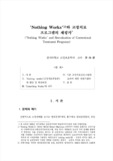

-
 * 본 문서는 배포용으로 복사 및 편집이 불가합니다.
* 본 문서는 배포용으로 복사 및 편집이 불가합니다.
미리보기
서지정보
· 발행기관 : 한국교정학회
· 수록지 정보 : 矯正硏究 / 36권
· 저자명 : 李白哲
목차
'Nothing Works'와 교정치료프로그램의 재평가
Ⅰ. 서론
Ⅱ. ‘Nothing Works’(교정치료 프로그램 무용론)의 발단 및 확산배경
Ⅲ. 'Something works'의 대두
Ⅳ. 기존 교정치료프로그램의 효과에 대한 재평가결과
Ⅴ. 결론
참고문헌
ABSTRACT영어초록
One of the issues that has influenced correctional policy since the 1970s has been the evaluation of the outcome of correctional treatment programs. While the public supports the concept of rehabilitation and correctional officials value them as effective means of changing inmates, there should at least exist an expectation that those programs will reduce recidivism. The ‘nothing works doctrine’, derived from Martinson's article, contributed in the disappearance of expectation and faith for correctional treatment programs. The reasons why Martinson's article of 'nothing works' have been so influential to academic as well as societal and political areas are explained in various respects: social and political climates of the 1960s-1970s characterized by anti-war moods, racial problems, poverty issues, and women's liberation, the changes of middle-class & liberal criminologists' attitudes towards crime and crime control, the politicization of crime problems, the domination of sociological approaches in criminology, and the lack of knowledge and skills in crime predictions by academics. In the US, rehabilitation as a correctional ideology had been retreating since early 1970s and almost disappeared in the mid 1980s as a goal of punishment, indicating that the retribution paradigm had returned. It is persuasive that such shifts resulted from political and societal reactions of conservatives and liberals toward crime, and are shown in correctional areas. In this context, some scholars has said that the society must move beyond the naivete and exuberance that marked the advocacy of rehabilitation in the 1950s and early 1960s and beyond the cynicism and pessimism that has reigned for much of the last three decades.(Palmer, 1992) This notion has received widespread support. New evaluation studies, including meta-analyses done after Martinson's article in 1974, indicate that correctional treatment programs could be effective in reducing criminal recidivism. And they have demonstrated that juvenile correctional intervention is more effective than intervention programs designed for adults. It has been known that behavioral/cognitive treatment, on average, produces larger effects than other treatment. Intensive, in-prison drug treatment is effective, especially when combined with community aftercare. Education, vocational training, and prison labor programs have modest effects on reducing criminal recidivism and increase positive behavior in prison. Evidence on sex offender treatment intervention program is less positive, probably because the target population is heterogeneous and treatment needs to be tailored to specific offender deficits.(Gaes et al., 1999) The results of meta-analyses seem to show that the programs for probationers or juvenile offenders with community aftercare are inclined to be more effective. There have been major theoretical and methodological advances in the juvenile and adult correctional treatment literature since Martinson's assessment study. Expecially, adaptation of the psychological learning model and meta-analysis as a statistical technique to criminology and corrections have been known to contribute in formulating principles for successful treatment programs though those principles need further clarification and empirical assessment. The following are suggested as principles of successful correctional treatment: linkage with criminogenic needs, multimodal programs for various deficits, matching client learning styles with staff teaching styles, treatment based on risk differentiation, providing skills oriented to cognitive-behavioral treatment, implementing programs with continuity of care and sufficient dosage, and involvement in both program development and evaluation by researchers.참고자료
· 없음태그
-
자료후기
Ai 리뷰이 자료는 깊이 있는 내용과 함께 과제에 적용 가능한 내용이 많아 도움이 되었습니다. 과제에 바로 활용할 수 있어 매우 만족스러웠습니다. 감사합니다. -
자주묻는질문의 답변을 확인해 주세요

꼭 알아주세요
-
본 학술논문은 (주)코리아스칼라와 각 학회간에 저작권계약이 체결된 것으로 AgentSoft가 제공 하고 있습니다.
본 저작물을 불법적으로 이용시는 법적인 제재가 가해질 수 있습니다. -
해피캠퍼스는 구매자와 판매자 모두가 만족하는 서비스가 되도록 노력하고 있으며, 아래의 4가지 자료환불 조건을 꼭 확인해주시기 바랍니다.
파일오류 중복자료 저작권 없음 설명과 실제 내용 불일치 파일의 다운로드가 제대로 되지 않거나 파일형식에 맞는 프로그램으로 정상 작동하지 않는 경우 다른 자료와 70% 이상 내용이 일치하는 경우 (중복임을 확인할 수 있는 근거 필요함) 인터넷의 다른 사이트, 연구기관, 학교, 서적 등의 자료를 도용한 경우 자료의 설명과 실제 자료의 내용이 일치하지 않는 경우
“矯正硏究”의 다른 논문도 확인해 보세요!
-
가정폭력행위자 교정․치료프로그램의 개선방안 17 페이지
가정폭력은 다른 폭력보다도 지속적이고, 은밀하고 반복적이며, 폭력성향의 대물림 경향을 보이는 등 그 폐해가 실로 크다. 따라서 이에 대한 적극적인 근절 대책이야말로 사회 전반에 만연된 폭력문화에 대한 근본적인 치유책이 될 수 있다는 확고한 인식이 필요하다. 가정폭력에 대한 단순한 형사처벌은 가정의 평화와 안정의 회복보다는 가정의 해체를 초래할 수 있다. 따.. -
형집행정지제도 운용상 문제점 및 개선 방안 연구 23 페이지
형집행정지란 법원으로부터 징역, 금고, 구류 등 자유형을 선고 받고 형이 확정되어 교도소 등에 수감되어 있는 수형자에게 형사소송법 제470조1항 동법 제 471조 1항 각호에 해당 하는 인도적 사유가 있을 때 수형자 누구에게나 공평하게 형의 집행 목적 이외에 어떤 불이익을 주지 않기 위한 제도이다. 그러나 일부 언론 등에서 검찰이 정치인, 경제인, 고위공직.. -
해외사례를 통한 교정시설 민영화에 관한 고찰 22 페이지
-
현행 소년법상 보호처분의 문제점과 개선방안 - 법무부․대법원의 소년법개정시안에 대한 검토를 포함하여 - 25 페이지
-
교정복지 구현의 사회적 의의와 정책적 과제 29 페이지
지금까지 우리사회는 범죄인에 대하여 개인적 책임에 상응하는 엄정한 처벌 중심으로 대응하고 있다. 그리고 거기에 보태어 처벌 후에도 사회적 낙인을 부여하는 등으로 좀처럼 그들의 새로운 삶을 인정하지 않으려는 사회적 분위기가 존재한다. 그것은 그들에게 또 한 번의 왜곡된 삶을 강요하게 되고 그 결과는 그들을 포함한 우리사회 전체의 질곡으로 되돌아오는 반복성을 ..
문서 초안을 생성해주는 EasyAI

